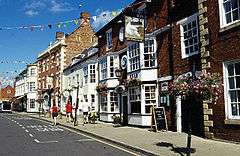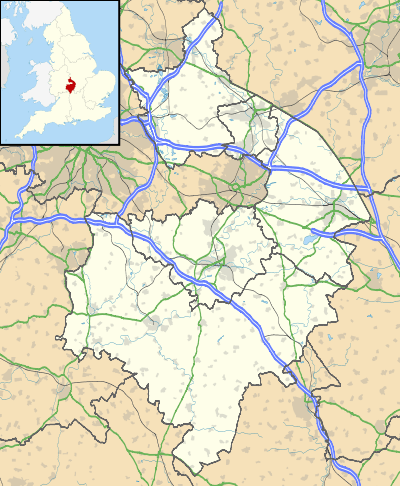Shipston-on-Stour
Shipston-on-Stour is a town and civil parish in the Stratford-on-Avon District and is the main settlement of the southern corner (projection) of Warwickshire, England. The compactly formed town and its associated land occupy the left bank of the River Stour 9.3 miles (15 km) SSE of Stratford-upon-Avon and 12.4 miles (20 km) south of Warwick.
| Shipston-on-Stour | |
|---|---|
 High Street, Shipston | |
 Shipston-on-Stour Location within Warwickshire | |
| Area | 4.92 km2 (1.90 sq mi) |
| Population | 5,038 (2011 Census)[1] |
| • Density | 1,024/km2 (2,650/sq mi) |
| OS grid reference | SP2540 |
| Civil parish |
|
| District |
|
| Shire county | |
| Region | |
| Country | England |
| Sovereign state | United Kingdom |
| Post town | Shipston-on-Stour |
| Postcode district | CV36 |
| Dialling code | 01608 |
| Police | Warwickshire |
| Fire | Warwickshire |
| Ambulance | West Midlands |
| UK Parliament | |
| Website | Shipston-on-Stour Town Council |
This area is sometimes termed the Vale of the Red Horse, close to Oxfordshire and Gloucestershire.[2]
History
Etymology linked to sheep and wool trade
In the 8th century, the toponym was Scepwaeisctune,[3] Old English for Sheep-wash-Town. The place for many centuries had a sheep market. The name evolved through Scepwestun in the 11th century, Sipestone, Sepwestun and Schipton in the 13th century and Sepestonon-Sture in the 14th century.[3]
Church (vestry) administration, township and parish formation
It was a township in the parish of Tredington until 1720: by a Local Act of the 6th year of George I.[4] The town proved prosperous and generous to its church community — Church of England parish church of Saint Edmund has a 15th-century tower.[5] The Gothic Revival architect G.E. Street designed the rebuilding of the rest of the church in 1855.[5] The tower had a ring of five bells until 1695 when they were recast and rehung as a ring of six.[6] Since then all the bells have been recast and rehung from time to time, notably in 1754 and by John Taylor & Co. in 1979.[6]
A staging post for stagecoaches and regional market
Shipston is on the A3400 road (formerly part of the A34) between Stratford-upon-Avon and Oxford; it was from the 1600s to 1800s a staging place for stagecoaches. Former coaching inns, such as the Coach and Horses,[7] grace the High Street which has many listed buildings.
Following a fall in the demand for local wool, agricultural produce and manufactured goods were brought from 1836 via a branch line running from the horse-drawn Stratford and Moreton Tramway, built ten years before (linking Moreton-in-Marsh with Stratford (on Avon)).[4] In 1889 the line was upgraded to allow the operation of steam trains from Moreton to Shipston. Passenger services to the town were withdrawn in 1929 and the line ceased in 1960.
An early Victorian picture
Its first library and reading room were founded in 1837.[4] Manufacture of shag fabric for deep-pile carpets was for some decades a great business, but the place by 1848 had little manufacture or commerce but more than 1,800 residents.[4] Worcester Cathedral for most of the centuries of the existence of manorial rights owned the manorial rights and even in the 1840s held a court annually, at which a town constable was appointed.[4] Powers of the short-lived county debt court, established in 1847, extended over Shipston's civil registration district (established 1837). In that era the market was on Saturday and fairs in April, June, August and October. The rectory had Tidmington annexed and received net income of £700 with the benefit of patrons Worcester Cathedral and Jesus College, Oxford, the former presenting (appointing the priest) to every third vacancy. The church had extra seats, a gallery, erected in 1790.[4] Baptists, the Society of Friends, and Wesleyans each had a place of worship; and at Foxcote, in the parish, was a Roman Catholic chapel.[4] A national school (England and Wales) was endowed with about £130 per annum; and "various small bequests" were distributed among the poor.[4]
Poor law union and rural district
Shipston poor law union (c.1830-1894) administered those functions in 37 parishes or places, 20 of which in the county of Warwick, 13 in that of Gloucester, and 4 in that of Worcester; across in the 1840s a population of 19,685 people.[4]
From 1894 until 1974 Shipston boasted the offices and Council meetings of Shipston-on-Stour Rural District.
- County designation oddity
Shipston was in an exclave of (in the Oswaldslow Hundred of) Worcestershire until 1931, when it was transferred to Warwickshire.[8]
Amenities
The Sports Club has football,[9] cricket, bowls, tennis[10] and angling[11] clubs. Shipston First Scout Group has Beaver (ages 6–8), Cub (ages 8–10½) and Scout (ages 10½–14) sections.[12] Shipston on Stour Rugby Football Club currently plays in the Midlands 3 West (South) league.[13] Shipston has a brass band.[14]
Shipston has a small museum located off Telegraph Street.[15] The museum was set up, and is run by local people. It is stocked with artifacts and memorabilia relating to the town and the surrounding villages.
Notable people
Notable people connected with Shipston include:
- Cy Endfield, American-born director of such notable films as Hell Drivers and Zulu; he had emigrated to England and lived and died in Shipston after being blacklisted as a Communist during the McCarthy era.
- Robin Gibb of the Bee Gees mentions Shipston in his song "Cold Be My Days", which was not released until 2015 although recorded in 1970 for the unfinished album Sing Slowly Sisters; words "Cold be my days in Shipston-on-Stour" appear several times. He stated in a BBC Radio 4 interview in May 2007 that this relates to his youthful experiences, riding horses with his brother Barry.[16]
- Francis Haverfield - 19th-century archaeologist, born in Shipston.[17]
- Richard Morant - film and TV actor, born in Shipston.[18]
- Simon Travis, former professional footballer, has recently moved to the town.
References
- UK Census (2011). "Local Area Report – Shipston on Stour Parish (E04009778)". Nomis. Office for National Statistics. Retrieved 29 September 2019.
- Beckinsale, R. (1980) The English Heartland, Duckworth, p.5
- Victoria County History 1913, pp. 521–524
- A Topographical Dictionary of England, Samuel Lewis (London, 1845), vol. IV page 86.
- Pevsner & Wedgwood 1966, p. 395
- Chester, Mike. "Shipston on Stour St Edmund". Church Bells of Warwickshire. Archived from the original on 19 July 2011.
- "Coach and Horses in Shipston-on-Stour". Find a Hook Norton Pub. 2013. Archived from the original on 22 September 2015. Retrieved 4 June 2013.
- Stratford-on-Avon District Council Shipston-on-Stour History Archived 26 August 2014 at the Wayback Machine – Retrieved 22 August 2014
- "sefc.eu". Shipstonexcelsior.co.uk. Archived from the original on 23 July 2013. Retrieved 22 July 2017.
- "Home". shipstonangling.com. Retrieved 22 July 2017.
- "Scouts - Item". Scouts. Retrieved 31 December 2015.
- "Archived copy". Archived from the original on 14 July 2014. Retrieved 11 July 2014.CS1 maint: archived copy as title (link)
- "Welcome". Shipstonband.co.uk. Archived from the original on 7 September 2017. Retrieved 22 July 2017.
- "Museum | Shipston Tourism". www.visitshipston.org. Retrieved 31 December 2015.
- Lost Albums: Sing Slowly Sisters (BBC4 documentary.) The song "Cold Be My Days" in connection to Shipston-on-Stour is mentioned, at 15:16. Souncloud.com
- "Francia Haverfield archives". National Archives. Retrieved 26 June 2020.
- III, Harris M. Lentz (10 January 2014). "Obituaries in the Performing Arts, 2011". McFarland – via Google Books.
Sources
- Allen, Geoff (2000). Warwickshire: Towns and Villages. Towns & villages of Britain. Sigma Leisure. ISBN 1-85058-642-X.CS1 maint: ref=harv (link)
- Pevsner, Nikolaus; Wedgwood, Alexandra (1966). Warwickshire. The Buildings of England. Harmondsworth: Penguin Books. pp. 395–396.CS1 maint: ref=harv (link)
- "Shipston-on-Stour". A History of the County of Worcester, Volume 3. Victoria County History. London. 1913. pp. 521–524.
